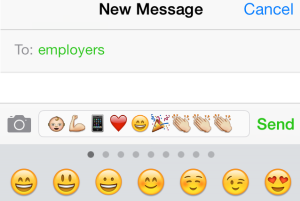You are all super savvy about hiring trends, of course you are… you read this blog! So, you all know that mobile is very important when it comes to social recruiting. What you may not know, is that the importance of having a mobile hiring strategy is even greater when it comes to recruiting passive candidates.
Passive candidates choose mobile over desktop, when looking for work, even more frequently than their active counterparts.
This probably has something to do with the fact that they are currently employed, and can’t exactly spend their days researching job posts on their company computers! In fact, many of the candidates you’re looking for don’t have any access to a computer while at their job. Retail workers, for example, spend their days on the store floor, making sales, dusting display units, and checking their Facebook accounts. They are also checking out potential employers on their smart phones.
In a recent survey by Jobvite, 21% of passive candidates admitted to using their smart phones to look for a new position, when at work. Naughty! Those candidates are also looking for work while they wait for the bus, while they wait for their morning muffin, and even while they use the restroom (at least 7% of them!)
So how do you get your job posts onto their smart phones, their iPads, and into their restrooms?
Tweet your job posts
Twitter doesn’t really work as a primary social platform for recruiting. It does, however, make for a top notch second in command. Twitter is a quick easy, way to let people know you’re hiring.
I like to break down effective strategy for using Twitter to improve mobile recruiting into three steps: build it, tweet it, tag it!
Build up your Twitter employer brand by posting images, sharing quick tips, and interacting with other tweeters in your field.
Tweet your jobs. Every time you post a job, tweet it, and then tweet it again! Twitter feeds fill up quickly, so you should tweet the post at least a couple times a day until the position is filled. Just make sure to intersperse those tweets with other valuable content.
Tag everything you post, everything! Use niche hashtags to make your tweets searchable, this will build your brand and talent pool. Tag your job posts with #hiring. Always, always, always #hiring! Mostly because this is the number one hashtag career advice bloggers tell job seekers to look for.
Here are the top 50 hashtags you should use when recruiting with Twitter.
Make your application process mobile friendly
Most career sites are not mobile; in fact, our own survey found that around 90% of career sites were not mobile friendly. This has got to change! But, until it does, there are some ways around it.
Use social networks to share your jobs. Yet another way Twitter can benefit your passive candidates recruiting! Take advantage of the mobile friendliness of apps like Google+, Instagram, and Facebook to get your job posts seen.
You can also create a Facebook career section for your company Page and post your jobs there. Your career section will be viewable to Facebook users via their mobile app, so all those passive candidates, who really ought to be working, can be looking at your job posts instead! Win-win!
Here’s how you can make your Facebook recruiting mobile friendly
Focus on Facebook over LinkedIn
Yes I am biased. No this is not the (only) reason I am giving you this advice.
84% of job seekers are active on Facebook. Only 36% of them are active on LinkedIn.
Nuff said.
Oh, except that passive candidates are even less likely to use LinkedIn in their job search, or to have up to date LinkedIn profiles (if they have one at all). LinkedIn is still a useful tool for connecting with other professionals and recruiting them, but for reaching the vast majority of passives candidates, hourly workers, and anyone under 35 Facebook is a better bet.
This article does a great job of explaining the difference between LinkedIn and Facebook for recruiting
Hopefully you’ve found some helpful info to help you recruit some passive talent. If you have any questions, or other topics you’d like us to cover, let us know in the comments.
Happy social recruiting!









